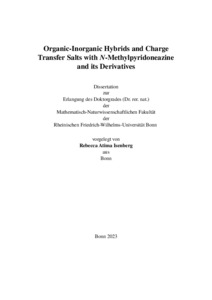Organic-Inorganic Hybrids and Charge Transfer Salts with N-Methylpyridoneazine and its Derivatives

Organic-Inorganic Hybrids and Charge Transfer Salts with N-Methylpyridoneazine and its Derivatives

| dc.contributor.advisor | Beck, Johannes | |
| dc.contributor.author | Isenberg, Rebecca Atima | |
| dc.date.accessioned | 2023-11-13T15:24:20Z | |
| dc.date.available | 2023-11-13T15:24:20Z | |
| dc.date.issued | 13.11.2023 | |
| dc.identifier.uri | https://hdl.handle.net/20.500.11811/11133 | |
| dc.description.abstract | The pyridone azine N-methylpyridoneazine (MPA, 1) is electron-rich and a planar organic donor molecule. As two-stage redox system, it can undergo two one-electron oxidation steps forming a radical cation species and an azo-bis(N-methyl-2,2’-pyridinium) dication. Its structural and electronic features make it highly attractive candidate for the generation of organic-inorganic hybrid solids and organic charge transfer (CT) salts with exotic magnetic and conducting characteristics.
Modifications of the basic scaffold MPA provide the pyridone azines 3-8. The +M substituents OMe and SMe, the steric demanding tBu group and the –I substituents F and CF3 in meta- or para-position of the pyridinium N atoms and a constitutional isomer with 4,4’-substitution were investigated regarding their redox behaviour. Cyclic voltammetry shows that the two one-electron oxidation processes proceed fully reversible. Especially, for the CF3 derivatives, the reductive power of the molecules decreases significantly. The differentiation of the oxidation states 0, +1 and +2 of the azines is possible by the bond lengths in the central CNNC azine moiety. Reactions with copper(II) halides afford the one-electron transfer as well as the two-electron transfer. A series of new organic-inorganic hybrids were obtained in reactions with CuCl2 and CuBr2. Pyridone azines 1 and 8 in reactions with copper(II) halides yielded the radical cation salts (1)[CuCl2], (1)[CuBr2] and (8)[CuBr2]. Six new dication salts were obtained containing the azo-bis(N-methyl-4,4’-pyridinium) dication or the azo-bis(N-methyl-2,2’-pyridinium) dication. (1)[Cu2Br44], α-(2)[Cu<2Br4], β-(2)[Cu2Br4]·CH3CN, (2)[CuBr3], (2)[CuBr4] and (8)[CuBr4] are synthesised successfully. Especially, the twofold oxidation of 2 afforded a multi-phase system. In the crystals, the common structural feature is stacks made up by the corresponding azine cation species. The corresponding bromido cuprate anions differ regarding the oxidation state of copper, the number of bromine ligands as well as their structural coordination. The magnetic properties are predominantly determined by the oxidation state of copper. However, in case of (8)[CuBr2] the magnetism is dominated by the 8·+ radical cation. For the conducting properties of the organic-inorganic hybrids even the respective cation as the anion are responsible. Overall, they represent small band gap semiconductors or typical insulators. Ten new charge transfer salts were obtained in reactions of the azines 1-8 with the organic acceptor molecules TCNQ, TCNP and DTeF: α-(1)(TCNQ), α-(2)(TCNQ), β-(2)(TCNQ), (3)(TCNQ), (4)(TCNQ), (7)(TCNQ), (7)(TCNQ)2, (8)(TCNQ), (5)(OTCNP)2, (7)(TCNP) and (1)(DTeF). Their structural arrangement consisting of mixed or segregated stacks yield various magnetic and conducting properties. Experimental results have a broad consensus with predicted electronic properties by band structure and PDOS calculations. Especially, the polymorphism observed for α-(2)(TCNQ) and β-(2)(TCNQ) expresses clearly the structure-property relationship. Thus, hybrid density functional theory with dispersion correction and triple-zeta basis sets represents a suitable method for the prediction of the electronic properties of CT salts. | en |
| dc.language.iso | eng | |
| dc.rights | In Copyright | |
| dc.rights.uri | http://rightsstatements.org/vocab/InC/1.0/ | |
| dc.subject | Charge-Transfer Salze | |
| dc.subject | Heterozyklische Azine | |
| dc.subject | Radikalkationen | |
| dc.subject | Charge transfer salts | |
| dc.subject | heterocyclic azines | |
| dc.subject | radical cations | |
| dc.subject.ddc | 540 Chemie | |
| dc.title | Organic-Inorganic Hybrids and Charge Transfer Salts with N-Methylpyridoneazine and its Derivatives | |
| dc.type | Dissertation oder Habilitation | |
| dc.publisher.name | Universitäts- und Landesbibliothek Bonn | |
| dc.publisher.location | Bonn | |
| dc.rights.accessRights | openAccess | |
| dc.identifier.urn | https://nbn-resolving.org/urn:nbn:de:hbz:5-72762 | |
| dc.relation.doi | https://doi.org/10.1002/zaac.202200020 | |
| ulbbn.pubtype | Erstveröffentlichung | |
| ulbbnediss.affiliation.name | Rheinische Friedrich-Wilhelms-Universität Bonn | |
| ulbbnediss.affiliation.location | Bonn | |
| ulbbnediss.thesis.level | Dissertation | |
| ulbbnediss.dissID | 7276 | |
| ulbbnediss.date.accepted | 25.08.2023 | |
| ulbbnediss.institute | Mathematisch-Naturwissenschaftliche Fakultät : Fachgruppe Chemie / Institut für Anorganische Chemie | |
| ulbbnediss.fakultaet | Mathematisch-Naturwissenschaftliche Fakultät | |
| dc.contributor.coReferee | Lützen, Arne |
Files in this item
This item appears in the following Collection(s)
-
E-Dissertationen (4339)




